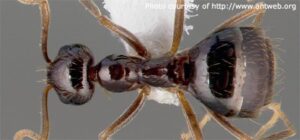Introduction to Pheromones
 The insect world is very diverse with around 900,000 different kinds of living insects. This representation approximates 80 percent of the world’s species. While humans can communicate by talking, insects need to communicate through the use of pheromones. Pheromones are chemicals used by insects and other animals to communicate between each other. Insects send these chemical signals to help attract mates, warn others of predators, find food or to attack a threat. These chemicals can be divided or classified into the following species in function: trace pheromones (to locate a food source), aggregation pheromones (to find individuals of the same species), alarm pheromones (to warn any sort of danger) and sex pheromones (to attract adults of the opposite sex for mating). Pheromones are also used to control insects through mating disruption, mass trapping, monitoring and “Attracting and killing.” The different uses of the pheromones will be dependent on the target insect. For example, Indian Meal Moths (Plodia interpunctella) can be controlled using mating disruption which impedes the encounter between both sexes and essentially stops the life cycle. This works using several different modes of action. This product effects moths by causing sensory overload, false trail following or delayed or denied mating. “Attracting and killing” attracts the insects to the designated location and kill them, just similar to mass trapping method. The use of pheromone traps are a common method for mass trapping, but at the same time monitoring for the presence of a pest. Most pheromone traps only attract the adult insects while the destructive larvae are still present.
The insect world is very diverse with around 900,000 different kinds of living insects. This representation approximates 80 percent of the world’s species. While humans can communicate by talking, insects need to communicate through the use of pheromones. Pheromones are chemicals used by insects and other animals to communicate between each other. Insects send these chemical signals to help attract mates, warn others of predators, find food or to attack a threat. These chemicals can be divided or classified into the following species in function: trace pheromones (to locate a food source), aggregation pheromones (to find individuals of the same species), alarm pheromones (to warn any sort of danger) and sex pheromones (to attract adults of the opposite sex for mating). Pheromones are also used to control insects through mating disruption, mass trapping, monitoring and “Attracting and killing.” The different uses of the pheromones will be dependent on the target insect. For example, Indian Meal Moths (Plodia interpunctella) can be controlled using mating disruption which impedes the encounter between both sexes and essentially stops the life cycle. This works using several different modes of action. This product effects moths by causing sensory overload, false trail following or delayed or denied mating. “Attracting and killing” attracts the insects to the designated location and kill them, just similar to mass trapping method. The use of pheromone traps are a common method for mass trapping, but at the same time monitoring for the presence of a pest. Most pheromone traps only attract the adult insects while the destructive larvae are still present.
Submitted by: Rich Gibson, ACE, CFSQA
The Small Honey Ant

Order: Hymenoptera Family: Formicidae Genus: Prenolepis Species: P. imparis
Prenolepis imparis, commonly known as the small honey ant, winter ant, false honey ant, or false honeypot ant, is a species of ant in the genus Prenolepis. The workers are small golden yellow to brown, about 1/8-inch (3.5 mm). Stiff hairs are present on the abdomen and thorax. First segment of antenna is longer than the top of the head. Pedicel looks heart-shaped when viewed from front or back. When full of food from foraging, these ants have swollen gasters (abdomen).
These ants build nests in open, well-shaded areas, seldom under items such as logs or stone. You may find nests in soil under shrubs and landscaping beds. The nest consists of numerous small galleries dug in the soil and excavated soil particles are deposited in a crater-shaped mound. Ants forage in easily detected trails. This ant prefers sweets and tends aphids for the honeydew that is produced, but may forage on sweets in the kitchen.
The small honey ant is a native species, sometimes referred to as the false honey ant. It is also known as the winter ant, because it is more cold tolerant than other species that infest structures. It ranges from Ontario, Canada, to Nebraska, south to Texas and Florida, and also occurs in New Mexico, California, Oregon and Washington.
These ants commonly invade buildings from outdoors but are capable of nesting indoors. Their nests may occur in soil associated with slab expansion joints. Entire colonies have been collected from potted plants. Small honey ants are persistent invaders and forage in trails. Treatments should be made by injecting an appropriate residual insecticide, using a compressed air sprayer equipped with a crack-and-crevice tip, into the cracks and crevices. Indoors, a light amount of residual insecticide dust can be injected into cracks and crevices in uncarpeted areas where ants disappear into cracks.
Submitted by: Rich Gibson, ACE, CFSQA
Infested Plastic Bottles

A packaging manufacturer received numerous complaints from their customer of dead American Cockroaches being found in and on pallets of food packaging, plastic bottles. The trailers of packaging were being rejected almost weekly and the end user of the packaging received several complaints from their consumers.
RK Environmental Services, which did not provide service to the facility, conducted an Integrated Pest Management (IPM) assessment to determine the source of the activity and recommend the best course of action. The facility which manufactured the bottles was thoroughly inspected and historical IPM contract service provider reports were reviewed. The manufacturing facility had no evidence of pest activity and there were no reports of sightings by employees or the contract service provider.
The manufacturing facility produced the bottles, loaded them onto trailers and shipped the product to an offsite warehouse several miles away. The trailers would sit in the warehouse lot for several days before being unloaded and placed in storage for additional weeks and months before being loaded into customer provided trailers for distribution to the different manufacturers.
The warehouse was located in a semi-rural area with a river nearby. An inspection of the grounds and facility showed no immediate evidence of pest activity. During the inspection, however, some ornamental rocks were overturned, and American Cockroaches (ACR) were found. Further inspection of the landscaping showed countless ACRs in the immediate vicinity of the building and trailer lot. With the new discovery, focus was placed on the storage and transfer trailers.
The trailers used for shuttling the bottles from the manufacturer to the warehouse were not in the best condition. Many trailers were damaged, had visible openings, holes, etc. It was determined the trailers were the concern that needed to be addressed.
The client leased new trailers and implemented a 24 hour policy on leaving trailers in the lot. Ensuring these trailers did not sit for too long before being unloaded. This non-chemical control method was effective and no complaints were reported after the new process was implemented.
- Take Away Tips:
- A fresh set of eyes can yield the best results.
- The source may not always be obvious.
- Sometimes you must dig deeper.
- Chemicals are not always the answer.
Submitted by: Rich Gibson, ACE, CFSQA






